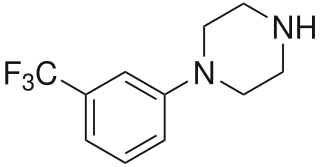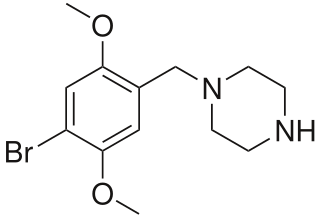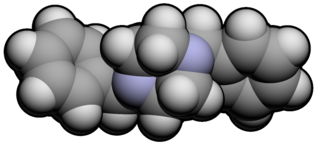
Club drugs, also called rave drugs or party drugs, are a loosely defined category of recreational drugs which are associated with discothèques in the 1970s and nightclubs, dance clubs, electronic dance music (EDM) parties, and raves in the 1980s to today. Unlike many other categories, such as opiates and benzodiazepines, which are established according to pharmaceutical or chemical properties, club drugs are a "category of convenience", in which drugs are included due to the locations they are consumed and/or where the user goes while under the influence of the drugs. Club drugs are generally used by adolescents and young adults.
A designer drug is a structural or functional analog of a controlled substance that has been designed to mimic the pharmacological effects of the original drug, while avoiding classification as illegal and/or detection in standard drug tests. Designer drugs include psychoactive substances that have been designated by the European Union as new psychoactive substances (NPS) as well as analogs of performance-enhancing drugs such as designer steroids. Some of these were originally synthesized by academic or industrial researchers in an effort to discover more potent derivatives with fewer side effects and shorter duration and were later co-opted for recreational use. Other designer drugs were prepared for the first time in clandestine laboratories. Because the efficacy and safety of these substances have not been thoroughly evaluated in animal and human trials, the use of some of these drugs may result in unexpected side effects.

Benzylpiperazine (BZP) is a substance often used as a recreational drug and is known to have euphoriant and stimulant properties. Several studies conducted between 2000 and 2011 found that the effects of BZP are similar to amphetamine, although BZP's dosage is roughly 10 times higher by weight.

3-Trifluoromethylphenylpiperazine (TFMPP) is a recreational drug of the phenylpiperazine chemical class and is a substituted piperazine. Usually in combination with benzylpiperazine (BZP) and other analogues, it is sold as an alternative to the illicit drug MDMA ("Ecstasy").

Piperazine is an organic compound that consists of a six-membered ring containing two nitrogen atoms at opposite positions in the ring. Piperazine exists as small alkaline deliquescent crystals with a saline taste.
Lacing or cutting, in drug culture, refer to the act of using a substance to adulterate substances independent of the reason. The resulting substance is laced or cut.

meta-Chlorophenylpiperazine (mCPP) is a psychoactive drug of the phenylpiperazine class. It was initially developed in the late-1970s and used in scientific research before being sold as a designer drug in the mid-2000s. It has been detected in pills touted as legal alternatives to illicit stimulants in New Zealand and pills sold as "ecstasy" in Europe and the United States.

para-Methoxyphenylpiperazine is a piperazine derivative with stimulant effects which has been sold as an ingredient in "Party pills", initially in New Zealand and subsequently in other countries around the world.

para-Fluorophenylpiperazine is a piperazine derivative with mildly psychedelic and euphoriant effects. It has been sold as an ingredient in legal recreational drugs known as "Party pills", initially in New Zealand and subsequently in other countries around the world.

Piberaline is a psychoactive drug and member of the piperazine chemical class which was developed in the 1980s. It has stimulant and antidepressant effects which are thought to be due largely to its active metabolite benzylpiperazine. It was researched to a limited extent in Hungary and Spain, but was not widely accepted and does not seem to be in current use, although a closely related drug befuraline with similar effects has been slightly more successful.

Methylbenzylpiperazine is a stimulant drug which is a derivative of benzylpiperazine. MBZP has been sold as an ingredient in legal recreational drugs known as "party pills", initially in New Zealand and subsequently in other countries around the world.

4-Bromo-2,5-dimethoxy-1-benzylpiperazine (2C-B-BZP) is a psychoactive drug and research chemical of the piperazine chemical class which has been sold as a "designer drug". It produces stimulant effects similar to those of benzylpiperazine (BZP).

Dibenzylpiperazine (DBZP) is a piperazine derivative often found as an impurity in the recreational stimulant drug benzylpiperazine (BZP). Presence of DBZP is a marker for low quality or badly made BZP. It can be made as a reaction byproduct during BZP synthesis, either because the reaction has been run at too high a temperature, or because an excess of benzyl chloride has been used.

1-(3,4-Methylenedioxybenzyl)piperazine is a chemical compound of the piperazine chemical class related to benzylpiperazine (BZP). MDBZP has been sold as a designer drug and has even been found as an ingredient in street Ecstasy pills.

Mephedrone, also known as 4-methylmethcathinone, 4-MMC, and 4-methylephedrone, is a synthetic stimulant drug of the amphetamine and cathinone classes. Slang names include drone, M-CAT, White Magic, meow meow and bubble. It is chemically similar to the cathinone compounds found in the Khat plant of eastern Africa. It comes in the form of tablets or crystals, which users can swallow, snort or inject, producing effects similar to those of MDMA, amphetamines and cocaine.

Methylhexanamine is an indirect sympathomimetic drug invented and developed by Eli Lilly and Company and marketed as an inhaled nasal decongestant from 1948 until it was voluntarily withdrawn from the market in the 1980s.
A temporary class drug is a relatively new status for controlled drugs, which has been adopted in some jurisdictions, notably New Zealand and the United Kingdom, to attempt to bring newly synthesised designer drugs under legal control. The controlled drug legislation in these jurisdictions requires drug scheduling decisions to follow an evidence-based process, where the harms of the drug are assessed and reviewed so that an appropriate legal status can be assigned. Since many designer drugs sold in recent years have had little or no published research that could help inform such a decision, they have been widely sold as "legal highs", often for months, before sufficient evidence accumulates to justify placing them on the controlled drug schedules.
Substituted piperazines are a class of chemical compounds based on a piperazine core. Some are used as recreational drugs and some are used in scientific research.
Pre-workout is a generic term for a range of bodybuilding supplement products used by athletes and weightlifters to enhance athletic performance. Supplements are taken to increase endurance, energy, and focus during a workout. Pre-workout supplements contain a variety of ingredients such as caffeine and creatine, differing by capsule or powder products. The first pre-workout product entered the market in 1982, and since then the category has grown in use. Some pre-workout products contain ingredients linked to adverse effects. Although these products are not regulated, the Food and Drug Administration (FDA) warns consumers to be cautious when consuming them.

3-Methylbenzylpiperazine (3-Me-BZP) is a stimulant drug which is a derivative of benzylpiperazine. It has been sold as a designer drug, first being identified in Sweden in February 2012.















